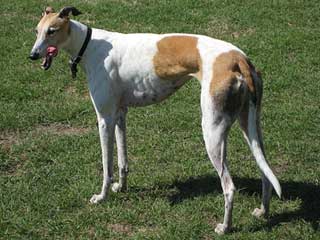| Grooming: |  |  |  |  |  |  |
| Shedding: |  |  |  |  |  |  |
| Energy Level: |  |  |  |  |  |  |
| Protection: |  |  |  |  |  |  |
| Watch Dog: |  |  |  |  |  |  |
| Group: | Hound |
| Size: | Large |
| Life Span: | 10-12 years |
| Height: | Male: 28-30 inches |
| Female: 26-28 inches | |
| Weight: | Male: 65-75 lbs |
| Female: 60-70 lbs |
Greyhound Facts
| Coat : | Short, dense and smooth |
| Gait : | Strong and powerful |
| Color(s) : | Black, fawn, red, blue, brindle etc. |
| Living Area : | Average |
| Hair Length: | Short |
| Exercise Need : | Daily long walk |
| Recognized By : |
(CKC) Canadian Kennel Club (FCI) F�d�ration Cynologique Internationale (AKC) American Kennel Club (UKC) United Kennel Club (KCGB) Kennel Club of Great Britain (CKC) Canadian Kennel Club (ANKC) Australian National Kennel Council (NKC) National Kennel Club (NZKC) New Zealand Kennel Club (APRI) America Pet Registry, Inc. (ACR) American Canine Registry (DRA) Dog Registry of America |
| Date of Origin : | Ancient |
| Place of Origin : | Egypt |
| Todays Use : | Companion Dog |
| Originally Used : | Hare hunter |
| Other Name : | English Greyhound |
Greyhound Information
Greyhound Description:The Greyhound is one of the most ancient dog breeds. Depictions similar to this breed have been found dating back to 2nd Century BC. The exact origin of the breed is unknown. However, it is believed to have descended from the Sloughi, which was brought by the Persians to England in the 10th century. Another theory suggests that the Celtic tribe is responsible for bringing this breed to England, despite having larger hounds with them. In the olden days, it was primarily used for hunting hare as well as large game such as stag, beer etc. The origins of the name of the breed are also uncertain. The breed comes in a lot of other colors apart from grey, which rules out the color angle for the naming of the dog. A popular theory suggests that Greyhound translates to fair dog because of the lighter color of its coat. The breed was first recognized by the AKC in 1885. |
Greyhound Care & Grooming:The Greyhound is an average shedder. A firm brush once or twice in a week is sufficient to maintain a healthy looking coat. It should be bathed regularly. Its eyes and ears need to be cleaned properly. |
Greyhound Health Problems:The Greyhound is prone to some health issues like Bloat, Osteosarcoma, Hypothyroidism etc. |
| Group: | Hound |
| Size: | Large |
| Life Span: | 10-12 years |
| Height: | Male: 25-27 inches Female: 23-25 inches |
| Weight: | Male:55-75 lbs Female: 50-70 lbs |
| Color: | Black with tan markings |
| Description: | The origin of Black and Tan Coonhound lies in the United States. The breed dates ..... |












